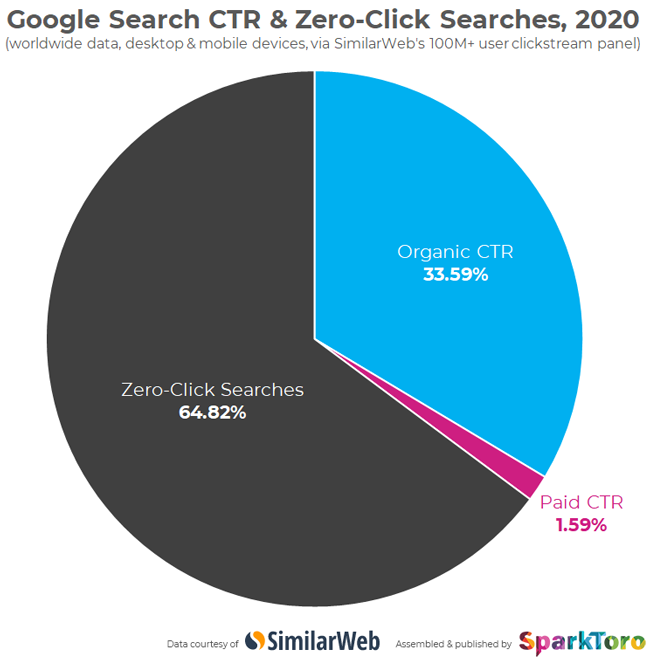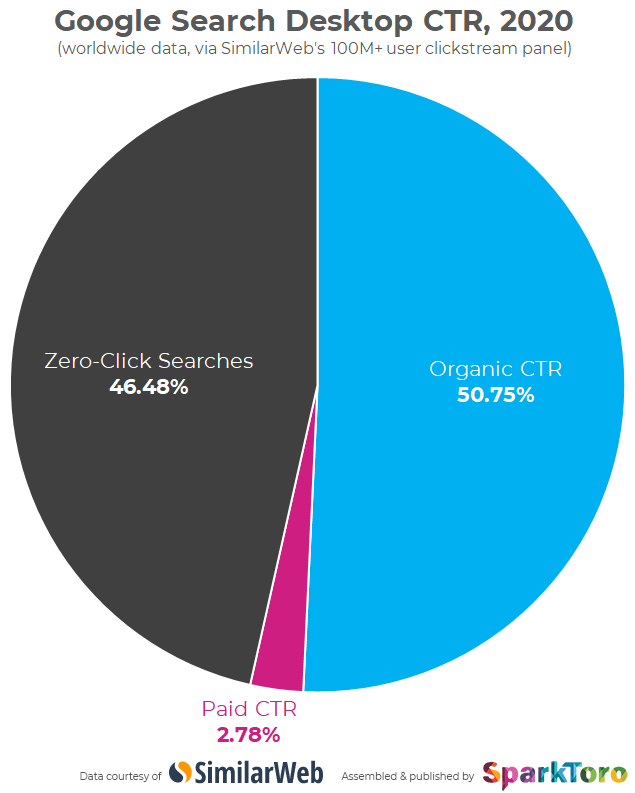In August of 2019, I published research from now-defunct clickstream data provider, Jumpshot, showing that 50.33% of all Google searches ended without a click to any web property in the results. Today, thanks to new data from SimilarWeb, I’ve got a substantive update to that analysis.
From January to December, 2020, 64.82% of searches on Google (desktop and mobile combined) ended in the search results without clicking to another web property. That number is likely undercounting some mobile and nearly all voice searches, and thus it’s probable that more than 2/3rds of all Google searches are what I’ve been calling “zero-click searches.” Some folks have pointed out that “zero-click” is slightly misleading terminology, as a search ending with a click within the Google SERP itself (for example, clicking on the animal sounds here or clicking a phone number to dial a local business in the maps box) falls into this grouping. The terminology seems to have stuck, so instead I’m making the distinction clear.
Comparison Warning: This data isn’t apples to apples with what I published in 2019. That’s because SimilarWeb’s panel of clickstream data is different than Jumpshot’s. For one, the data here is worldwide vs. my prior analysis on Jumpshot’s US-only panel. And SimilarWeb is combining both mobile and desktop devices, including Apple/iOS devices (which Jumpshot did not have coverage for). Nonetheless, it seems probable that if the previous panel were still available, it would show a similar trend of increasing click cannibalization by Google.
Here are the headline statistics from the data:
- SimilarWeb analyzed ~5.1 trillion Google searches in 2020
- These searches took place on the 100M+ panel of mobile and desktop devices from which SimilarWeb collects clickstream data
- Of those 5.1T searches, 33.59% resulted in clicks on organic search results
- 1.59% resulted in clicks on paid search results
- The remaining 64.82% completed a search without a direct, follow-up click to another web property
- Searches resulting in a click are much higher on desktop devices (50.75% organic CTR, 2.78% paid CTR)
- Zero-click searches are much higher on mobile devices (77.22%)
I’ve created a few visualizations of this data, but the full set of what SimilarWeb’s putting together is far richer. If you’re interested, I strongly encourage you to join us next week, March 31st at 1pm Eastern, 10am Pacific for The Evolution of Search webinar, which SimilarWeb’s kindly offered to have me co-host with their team.
The breakdown that’s most relevant is the separation of mobile vs. desktop CTRs.
As you can see above, the organic CTR on desktop is still more than 50%. Desktop (which includes laptops and larger tablets in this analysis), also showed quite a bit more paid CTR. In the United States, I suspect these numbers are larger, and in countries and regions with fewer advertisers and less ad dollars, it’s likely less.
The graphic above shows how different the picture is on mobile, which accounts for quite a bit more searches around the world, in the US, and in SimilarWeb’s panel. Here we see that Google’s efforts at a mobile-first search experience have paid immense dividends, answering a staggering 3/4ths of all mobile search queries without a click.
Scholars, economists, technologists, and hopefully a few folks in the antitrust world will likely draw their own conclusions about this data, and while I have strong opinions on the matter, I’ll let the numbers speak for themselves in this post.
I do, however, feel it’s important to set some context about Google’s monopoly power. In 2020, the search giant had more than 91% of the global market share worldwide, and over 87% in the US. As a GroupM study in the Wall Street Journal noted last week, Google also controls a massive share of all advertising in the US, including more than 95% of search advertising and over 50% of display ads.

But Google / Alphabet isn’t planning to stop there. As Gizmodo’s Shosana Wodinsky wrote in her breakdown of Google’s plans to replace advertising cookies with a proprietary, Google-owned system for aggregating user-behavior called FLoC:
“(T)his ploy would give Google exclusive access to a ton of user data that the company already largely monopolizes.”
That domination is a scary, but seemingly unstoppable prospect. Just as GDPR prevented any European tech company from ever competing against the US tech giants, so too does this “privacy” move appear to ensure that Google will own online advertising in search and the (non-Facebook/Amazon) web for the foreseeable future.
UPDATE (3/31): SimilarWeb provided additional data about the United States specifically. For Q4 of 2020, 68.3% of searches in the US ended without a click. Paid CTR was slightly higher, and organic CTR, more than 10% lower.

This makes sense, as Google’s US version often has more instant answers, featured snippets, knowledge boxes, etc. than other regions. The US also has more Google advertisers and ad spend than most other countries, hence paid is nearly 6% of all clicks in the US, vs. just over 5% worldwide (i.e. proportionally ~15% more).
For the final visual, I looked over time, from January 2018 (the furthest back SimilarWeb’s data went for this project) to December of 2020.

The trend over time is a bit bumpy, but we can see a number of interesting takeaways:
- Overall search volume is growing, though the pandemic may be responsible for the reverse from that dip at the end of 2019 (that might also be SW’s panel size shrinking; hard to know)
- Paid search share is clearly growing, and digging into the numbers, that’s true on both mobile and desktop
- Organic clicks grew in 2020 after a long plateau and slight drop. This looks to be from the rise in desktop use in 2020 (again, due to Covid-19 putting more of us on big screens), and thus could be slippery as vaccinations roll out.
- The end of 2020 recorded the highest-ever share of zero-click searches. It’s possible that Google’s experiment of limiting featured snippets in Q1 (which now looks to be over) could reveal fascinating correlations (I’ll ask SimilarWeb to follow up).
The good news: there are more searches on Google today than ever before, and more clicks available, too.
The bad news: in the last three years, Google’s been the overwhelming beneficiary of increasing worldwide search volume, and as the pandemic takes more people off their laptops and desktops and puts them back on their mobile devices, the zero-click search problem is likely to rise even more.
Reminder: The Evolution of Search webinar is next week, March 31st. If you’ve got more questions about this data or follow-ups for the SimilarWeb team, I encourage you to join. And if you have particular data points you’d like to see them assemble, feel free to leave those in the comments below (though I can’t promise they’ll get to anything in the one week timeframe).


